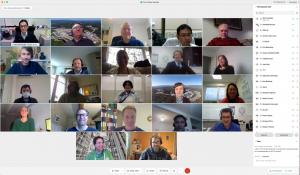ITER-JT-60SA collaboration in full swing
The ITER Organization is gaining knowledge and experience through active involvement in the commissioning activities underway on the JT-60SA tokamak in Japan. The valuable collaboration is made possible through a trilateral agreement with the partners of the Broader Approach, which is an agreement between Europe and Japan on advanced fusion activities.
The Broader Approach activities have been devised to complement ITER in the efforts towards the development of fusion energy. The projects under the Broader Approach are: the satellite tokamak JT-60SA; engineering validation design activities and a full-scale prototype of an accelerator to test new materials (IFMIF/EVEDA); and the International Fusion Energy Research Center (IFERC), which includes the realization and operation of a supercomputer and the implementation of next-phase (DEMO) design and R&D activities.
The first collaboration under the trilateral arrangement was launched in 2020, concurrently with the completion of assembly of the JT-60SA tokamak and the start of its integrated commissioning activities. Under the new collaboration, a work program of joint ITER-F4E-QST activities has been defined for 2020/2021 with focus on sharing of experience in the areas of tokamak assembly, system and integrated commissioning, and first plasma operation in JT-60SA. The acquisition of this experience is presently the highest priority for ITER, which began machine assembly this year, with the goal of minimizing risks in the coming years.
To that end, ITER staff have been informed of the procedures followed and lessons learned during JT-60SA machine assembly and are actively participating in the integrated commissioning activities presently in progress. While it was originally foreseen that several ITER staff members would be involved in-person at the QST Naka site, due to the COVID-19 restrictions most of the participation had to take place remotely and only one ITER staff member could be present at Naka this year. This notwithstanding, remote collaboration has been effective with ITER staff participating in JT-60SA weekly progress and planning meetings on integrated commissioning activities by teleconference, as well as in specially arranged meetings to share knowledge and experience gained by the JT-60SA team with a wide range of ITER specialists.
It is becoming increasingly clear that the knowledge and experience shared during the present phase of the JT-60SA program represents a unique opportunity for the ITER staff to refine plans for ITER's First Plasma phase, which includes integrated commissioning, First Plasma demonstration and operation of the ITER magnets to the nominal currents required for 15 MA plasmas. Soon after, from 2023 onwards, the IO-F4E-QST collaboration on the basis of the JT-60SA Research Plan will support the optimization of the ITER Research Plan and thus contribute to the achievement of ITER's fusion power production goals in the most effective way.
*QST = Japan's National Institutes for Quantum and Radiological Science and Technology



